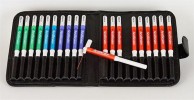Authors
X Cheng, F Xiao, R Xie, et al
Lab
The First Affiliated Hospital, Sun Yat-sen University, Guangzhou, PeopleÕs Republic of China.
Journal
The FASEB Journal
Abstract
Neuropathic pain (NP) is a common complication that negatively affects the lives of patients with spinal cord injury (SCI). The disruption in the balance of excitatory and inhibitory neurons in the spinal cord dorsal horn contributes to the development of SCI and induces NP. The calcium-binding protein (CaBP) calbindin-D 28K (CaBP28K) is highly expressed in excitatory interneurons, and the CaBP parvalbumin (PV) is present in inhibitory neurons in the dorsal horn. To better define the changes in the CaBPs contributing to the development of SCI-induced NP, we examined the changes in CaBP-28K and PV staining density in the lumbar (L4-6) lamina I and II, and their relationship with NP after mild spinal cord contusion injury in mice. We additionally examined the effects of alternate thermal stimulation (ATS). Compared with sham mice, injured animals developed mechanical allodynia in response to light mechanical stimuli and exhibited mechanical hyporesponsiveness to noxious mechanical stimuli. The decreased response latency to heat stimuli and increased response latency to cold stimuli at 7 days post injury suggested that the injured mice developed heat hyperalgesia and cold hypoalgesia, respectively. Temperature preference tests showed significant warm allodynia after injury. Animals that underwent ATS (15-18 and 35-40¡C; +5 minutes/stimulation/day; 5 days/week) displayed significant amelioration of heat hyperalgesia, cold hypoalgesia, and warm allodynia after 2 weeks of ATS. In contrast, mechanical sensitivity was not influenced by ATS. Analysis of the CaBP-28K positive signal in L4-6 lamina I and II indicated an increase in staining density after SCI, which was associated with an increase in the number of CaBP-28K-stained L4-6 dorsal root ganglion (DRG) neurons. ATS decreased the CaBP-28K staining density in L4-6 spinal cord and DRG in injured animals, and was significantly and strongly correlated with ATS alleviation of pain behavior. The expression of PV showed no changes in lamina I and II after ATS in SCI animals. Thus, ATS partially decreases the pain behavior after SCI by modulating the changes in CaBP-associated excitatory-inhibitory neurons.
BIOSEB Instruments Used:
Von Frey Filaments (Bio-VF-M)

 Douleur - Allodynie/Hyperalgésie Thermique
Douleur - Allodynie/Hyperalgésie Thermique Douleur - Spontanée - Déficit de Posture
Douleur - Spontanée - Déficit de Posture Douleur - Allodynie/Hyperalgésie Mécanique
Douleur - Allodynie/Hyperalgésie Mécanique Apprentissage/Mémoire - Attention - Addiction
Apprentissage/Mémoire - Attention - Addiction Physiologie & Recherche Respiratoire
Physiologie & Recherche Respiratoire
 Douleur
Douleur Métabolisme
Métabolisme Système moteur
Système moteur Neurodégénérescence
Neurodégénérescence Thématiques transversales
Thématiques transversales Système musculaire
Système musculaire Functions de motricité générale
Functions de motricité générale Troubles de l'humeur
Troubles de l'humeur Other disorders
Other disorders Joints
Joints Système Nerveux Central (SNC)
Système Nerveux Central (SNC)  Système sensoriel
Système sensoriel
